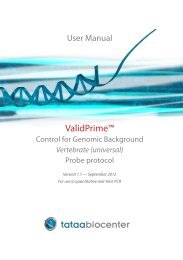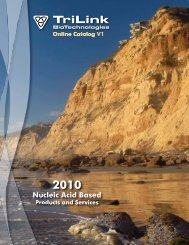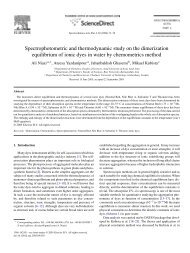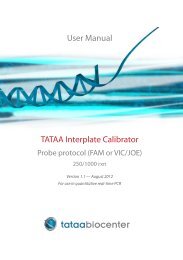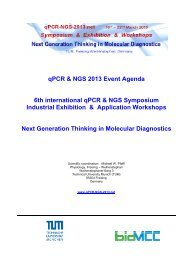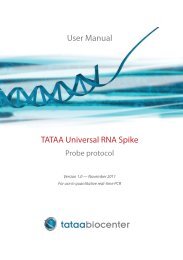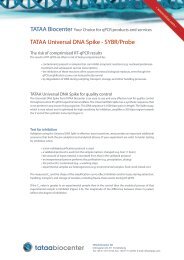BOXTO Manual - TATAA Biocenter
BOXTO Manual - TATAA Biocenter
BOXTO Manual - TATAA Biocenter
You also want an ePaper? Increase the reach of your titles
YUMPU automatically turns print PDFs into web optimized ePapers that Google loves.
User <strong>Manual</strong><br />
<strong>BOXTO</strong><br />
Control for Primer Dimers<br />
in Probe based qPCR assays<br />
Version 1.8 — Oct 2012<br />
For use in quantitative real-time PCR
<strong>BOXTO</strong><br />
Table of contents<br />
Background 4<br />
Fluorescence data 4<br />
Best of both worlds 5<br />
Contents 6<br />
Additionally required<br />
materials and devices 6<br />
Storage 7<br />
Instructions for use 7<br />
Troubleshooting 8<br />
References 9<br />
Contact 9<br />
License information 9<br />
Other products from <strong>TATAA</strong> 10<br />
ValidPrime Control for Genomic Background<br />
GenEx software<br />
Reference Gene Panel - Human or Mouse<br />
VisiBlue qPCR mix colorant<br />
CelluLyser - for rapid and easy lysis and cDNA synthesis<br />
TrulyStem - for Human Embryonic Stem Cell Characterization<br />
3
Background<br />
<strong>BOXTO</strong> is a derivative of BEBO, an unsymmetric cyanine dye developed by<br />
<strong>TATAA</strong> <strong>Biocenter</strong> for use in quantitative real-time PCR (qPCR) applications. The<br />
dye has absorbance and emission wavelengths that can be detected on the<br />
JOE channel on most common qPCR instrumentation and shows a very strong<br />
fluorescence increase when bound to dsDNA.<br />
<strong>BOXTO</strong> can be used as an unspecific dye for qPCR applications or other applications<br />
where staining of dsDNA is wanted. The BEBO-family of dyes are patent<br />
pending.<br />
Fluorescence data<br />
Maximum absorbance at 515 nm and maximum emission at 552 nm, when<br />
bound to dsDNA. Fluorescence increase is more than 250 times when bound to<br />
dsDNA. Maximum absorbance free in solution is at 482nm.<br />
4
<strong>BOXTO</strong><br />
Best of both worlds<br />
Since unspecific dyes also detect artefacts such as primer dimers, in some cases<br />
using sequence specific probes may be beneficial. On the other hand, when<br />
using probes dissociation curves cannot be performed to study what has been<br />
amplified in each reaction, and in some cases gel electrophoresis has to be performed<br />
to troubleshoot, leading to extremely high risk of contamination.<br />
<strong>BOXTO</strong> can be used in combination with any FAM-labeled probe and a dissociation<br />
curve can be performed after amplification. Quantification is then performed<br />
on the FAM-channel and dissociation curve on the JOE-channel.<br />
FAM-channel<br />
Probe<br />
JOE-channel<br />
<strong>BOXTO</strong> dye<br />
Figure: Using <strong>BOXTO</strong> in combination with a molecular beacon FAM-labeled probe. Acquiring<br />
on the FAM-channel does not detect the NTC containing only primer dimers<br />
(red curves). These are detected in the JOE-channel with <strong>BOXTO</strong> (top right) in the same<br />
reaction tube. Dissociation curve analysis can be performed after amplification using<br />
<strong>BOXTO</strong> on the JOE-channel. Here 0.7 µM of <strong>BOXTO</strong> was used in combination with 0.4<br />
µM of the molecular beacon probe.<br />
5
Contents<br />
• 5mM stock solution of <strong>BOXTO</strong> in DMSO. Sufficient for approximately 6000<br />
rxns.<br />
Additionally required materials and devices<br />
• Real-time PCR instrumentation<br />
This kit has been validated on several different instrument platforms.<br />
Note: Using <strong>BOXTO</strong> on certain instruments may need calibration. Most instruments<br />
can directly use the JOE-channel to monitor the <strong>BOXTO</strong> signal.<br />
• Mastermix or mastermix components<br />
The dye has been tested using many commercially available mastermixes, including<br />
Eppendorf Realplex Mastermix, Invitrogen Platinum qPCR Supermix-<br />
UDG, BioRad iQ Supermix, Quantace Sensimix, KAPA probe FAST Universal mix.<br />
Note: The use of <strong>BOXTO</strong> in certain mastermixes results in a lower and noisier amplification<br />
and dissociation curve signal. This has been noticed for example with<br />
Applied Biosystems TaqMan Universal Mastermix.<br />
<strong>BOXTO</strong> is compatible with ROX normalisation and dUTP containing mastermixes.<br />
• Pipettes and tips<br />
• Vortex and centrifuged<br />
• Sample cDNA<br />
When using cDNA as sample it is recommended to use cDNA of high quality.<br />
Quality of RNA can be checked prior to cDNA synthesis using Agilent 2100 Bioanalyzer<br />
or BioRad Experion.<br />
6
<strong>BOXTO</strong><br />
Storage<br />
The stock solution can be stored at -20 o C for 12 months. Once diluted in water<br />
the dye is preferably stored at +4 o C for 1 month. Repeated freeze-thaw cycles<br />
are not recommended.<br />
Instructions for use<br />
15 µl of stock solution is supplied at 5 mM in DMSO and is stable for 12 months<br />
in -20 o C.<br />
Before use dilute the stock to a working solution of 50 µM in mQ water by diluting<br />
the stock 1 µl + 99 µl. A solution of 50 µM (a 1+99 dilution) is stable for<br />
more than 1 month at 4 o C. Typical concentration in real-time PCR reactions is<br />
approximately 0.5 µM (concentrations around 0.3-2 µM can be tested). Detection<br />
should be done on the JOE channel. The dye can be used with most commercially<br />
available real-time PCR reagents. The quality of signal may depend<br />
on the chemistry used and on the filter settings on the real-time PCR platform.<br />
If the instrument used has variable gain settings, <strong>BOXTO</strong> should generally be<br />
used at a high gain setting.<br />
7
Troubleshooting<br />
• I do not get any amplification/signal?<br />
The instrument may not have been programmed correctly. You can evaluate if<br />
the problem is in the detection or the amplificiation by running the samples on<br />
gel. Make sure the <strong>BOXTO</strong> dye is monitored in the appropriate channel and that<br />
the instrument is calibrated if necessary.<br />
•I get a very noisy amplification and dissociation curve<br />
The quality of signal may depend on the chemistry used and on the filter settings<br />
on the qPCR platform. If the instrument used has variable gain setting, try<br />
to increase the gain. If the instrument requires calibration make sure also that<br />
this is performed. Changing the mastermix can also improve the signal.<br />
•My negative controls give a positive amplification?<br />
Since <strong>BOXTO</strong> is a dsDNA binding dye it will also bind to non-specific products<br />
such as primer dimers. Amplification of non-specific products will lead to an<br />
amplification signal. The amplified product can be evaluated by doing dissociation<br />
curve analysis.<br />
•My samples have same/higher Cq-value than my negative controls?<br />
This indicates that you have added too little DNA. Add more DNA and try again.<br />
The DNA may also be of low quality. Check the quality of the RNA before doing<br />
cDNA synthesis.<br />
•My replicates are not very tight?<br />
With good quality DNA and good pipetting technique, very high reproducibility<br />
is possible. Low amounts of DNA can lead to higher variation. Also, low quality<br />
DNA can lead to big differences between replicates.<br />
8
<strong>BOXTO</strong><br />
References<br />
M. Bengtsson, J. Karlsson, G. Westman and M. Kubista (2003) A new minor<br />
groove binding asymmetric cyanine reporter dye for real-time PCR, Nucleic Acid<br />
Research, Vol. 31, No. 8, 1-5<br />
H.J. Karlsson, P. Lincoln, G. Westman (2003) Synthesis and DNA Binding Studies<br />
of a New Asymmetric Cyanine Dye Binding in the Minor Groove of [poly(dAdT)]<br />
2<br />
. Bioorganic & Medicinal Chemistry, 11, 1035-1040<br />
K. Lind, A. Ståhlberg, N. Zoric, M. Kubista (2006), Combining sequence-specific<br />
probes and DNA binding dyes in real-time PCR for specific nucleic acid<br />
quantification and melting curve analysis, Biotechniques, Vol 3, 40, 315-319<br />
Contact<br />
For more information about the product and other products available from<br />
<strong>TATAA</strong> <strong>Biocenter</strong> contact us on support@tataa.com<br />
License information<br />
The purchase of this product conveys to the buyer the non-transferable right to use the purchased<br />
amount of the product and components of the product in research conducted by the buyer (whether<br />
the buyer is an academic or for-profit entity). The buyer cannot sell or otherwise transfer (a) this<br />
product (b) its components or (c) materials made using this product or its components to a third<br />
party or otherwise use this product or its components or materials made using this product or its<br />
components for commercial purposes. For information on purchasing a license to this product for<br />
purposes other than research, contact <strong>TATAA</strong> <strong>Biocenter</strong> AB, Medicinaregatan 8A, S-41346 Göteborg,<br />
Sweden, Phone: +46 31 741 18 00, Fax: +46 31 741 17 01, Email: info@tataa.com<br />
PCR is covered by several patents owned by Hoffman-La Roche Inc. and Hoffman-LaRoche, Ltd.<br />
Purchase of the product does not include or provide a license with respect to any PCR-related<br />
patent owned by Hoffman-La Roche or others. <strong>TATAA</strong> <strong>Biocenter</strong> does not encourage or support the<br />
unauthorised or unlicensed use of the PCR process.<br />
9
Other products from <strong>TATAA</strong><br />
ValidPrime Control for Genomic Background<br />
ValidPrime replaces the need to perform no reverse transcriptase (RT(-)) controls<br />
for all samples in your qPCR profiling to test for the presence of genomic<br />
DNA (gDNA). Just add the ValidPrime assay to the list of assays, and the gDNA<br />
control to the list of samples, and run. ValidPrime will minimize the amount of<br />
control reactions and hence your costs, as well as your efforts.<br />
GenEx software<br />
Market leading software for qPCR analysis. GenEx provides the appropriate<br />
tools to analyze qPCR gene expression data and to extract biologically relevant<br />
information from the measurements.<br />
Reference Gene Panel - Human or Mouse<br />
The panel contains primer sets for 12 commonly used human or mouse reference<br />
genes. A perfect product for finding the most optimal reference gene for<br />
your samples. GenEx Standard software with GeNorm and Normfinder is also<br />
included in the kit.<br />
VisiBlue qPCR mix colorant<br />
The VisiBlue mastermix colorant enables you to color your favourite qPCR mastermix<br />
to easily visualize where the reagent is loaded to your plates and tubes.<br />
VisiBlue is very easy to use by simple addition to your favorite mastermix.<br />
Universal RNA/DNA Spike - tests for inhibition and yield<br />
The <strong>TATAA</strong> Universal Spike is an easy to use and very effective tool for quality<br />
control throughout entire RT-qPCR experimental workflow. Add the spike<br />
to the experimental sample and to a control based on water. Processing both<br />
samples exactly the same way – any inhibition in the experimental sample will<br />
impair the RT-qPCR resulting in higher Cq than of the control sample. <strong>TATAA</strong><br />
Universal Spikes have a synthetic sequence that is not present in any known<br />
living organism. The Spike assay is exceedingly robust and is optimized for high<br />
sensitivity for inhibition. The Cq of the Spike assay also reflects losses during<br />
extraction, handling, transport, and storage of samples, including freeze-thaw<br />
events during RT-qPCR.<br />
10
Express your<br />
genius<br />
<strong>TATAA</strong> <strong>Biocenter</strong>, with offices in<br />
Gothenburg, San Francisco and<br />
Prague is the leading provider of<br />
real-time PCR services and the prime<br />
organizer of real-time PCR workshops<br />
globally. <strong>TATAA</strong> <strong>Biocenter</strong><br />
conducts commissioned research<br />
and training within field of molecular<br />
diagnostics and gene expression<br />
analysis, along with developing realtime<br />
PCR expression panels. <strong>TATAA</strong><br />
<strong>Biocenter</strong> has great experience and<br />
expertise in high resolution gene<br />
expression profiling, pathogen detection,<br />
and small sample/single cell<br />
analysis.<br />
<strong>TATAA</strong> <strong>Biocenter</strong> AB<br />
Odinsgatan 28, 411 03 Göteborg<br />
Tel: +46 31 761 57 00, Fax: +46 31 15 28 90<br />
E-mail: info@tataa.com, Website: www.tataa.com



